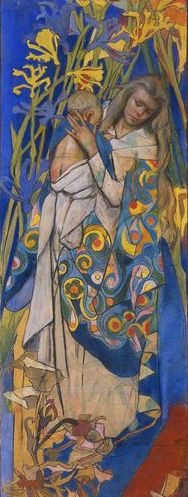
About the artist
STANISŁAW WYSPIAŃSKI (1869 Cracow - 1907 idem)
Son of Franciszek, woodcarver and sculptor, he attended
drawing classes in 1884, as an unenrolled student of the Academy
of Fine Arts in Cracow. He undertook regular studies in the
years 1887-89 under Florian Cynk, Izydor Jabłoński, Władysław Łuszczkiewicz and
Jan Matejko, interrupted by works on the polychrome in the St. Mary’s Church
aside Matejko. He continued his studies in the years 1890-95. Most of this time
he spent on scholarship in Paris (1890, 1891-92, 1893, 1894), where he studied
shortly at the Académie Colarossi at the ateliers of Gustave Courtois,
Joseph-Paul Blanc and Louis-Auguste Girardot, and where he first of all widened
his knowledge in contact with the new French art, while discovering the theatre
world and new trends in philosophy. These journeys were combined with artistic
peregrinations around Europe. In 1887-90 and
1896-97 he also studied at the faculty of philosophy at the Jagiellon University
in Cracow –
history, history of art and history of literature. In 1895 he settled down in Cracow; he was a member
founder of the Society of Polish Artists “Sztuka” in
1897, artistic director of the journal “Życie” in 1898-99. Since 1902 he was
responsible for the faculty of decorative and sacred painting at the Academy of Fine Arts, where in 1906 he became
professor; he was involved in works on the protection of monuments.
Wyspiański’s oeuvre comprises
different fields of art, mutually supplementing each other in a visionary
synthesis. The artist painted portraits
and landscapes, most frequently using the technique of a pastel; he designed
murals and stained glass windows, furniture, theatre costumes and stage
scenery, as well as typography; he was the author of 17 dramas and rhapsodies,
which he put on stage by himself most of the time. In his multifaceted art he
built his own vision of the man and the world, related to the existential
problems of the humanity, he drew from the past and from the historic tradition
of the nation, trying to reconcile these visions with the realism of the
present. In his easel painting for a short time he approached the
impressionism, but the characteristic feature of his monumental polychromes and
stained glass windows was the decorativeness of synthetics and nabis,
strengthened with a dramatic expression. In his sharply outlined portraits he
got out the psychology of personages with a strong, frequently curved line,
whereas children were treated with lyricism. In landscapes he combined observation
of nature with the eternal mystery of nature’s life, complicating their
symbolic meaning with historiosophic messages. After a long fight with a lethal
sickness, he died prematurely at the age of 38.
translated by Anna Kiełczewska
translated by Anna Kiełczewska

